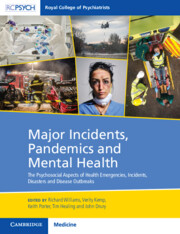 Major Incidents, Pandemics and Mental Health
Major Incidents, Pandemics and Mental Health from Section 6 - Designing, Leading, and Managing Responses to Emergencies and Pandemics
Published online by Cambridge University Press: 11 January 2024
During the COVID-19 pandemic, governments implemented a range of measures, ranging from public health campaigns promoting regular hand washing, wearing face masks, and practising social distancing, to closing businesses, restrictions on travel, prohibition of household mixing, and implementation of shelter-in-place lockdown orders. Although many of these measures were backed with the threat of fines or imprisonment, ultimately compliance requires active cooperation on the part of citizens, and some of these measures, notably closing businesses and implementing lockdown orders, entailed significant disruption to citizens’ lives, with potentially large material, financial, and psychosocial costs. This chapter summarises the literature on the patterns, determinants, and consequences of citizens’ preventive behaviours during COVID-19, paying particular attention to the role of socioeconomic factors in determining compliance. It offers some general lessons that may be applied to future pandemics.
To save this book to your Kindle, first ensure no-reply@cambridge.org is added to your Approved Personal Document E-mail List under your Personal Document Settings on the Manage Your Content and Devices page of your Amazon account. Then enter the ‘name’ part of your Kindle email address below. Find out more about saving to your Kindle.
Note you can select to save to either the @free.kindle.com or @kindle.com variations. ‘@free.kindle.com’ emails are free but can only be saved to your device when it is connected to wi-fi. ‘@kindle.com’ emails can be delivered even when you are not connected to wi-fi, but note that service fees apply.
Find out more about the Kindle Personal Document Service.
To save content items to your account, please confirm that you agree to abide by our usage policies. If this is the first time you use this feature, you will be asked to authorise Cambridge Core to connect with your account. Find out more about saving content to Dropbox.
To save content items to your account, please confirm that you agree to abide by our usage policies. If this is the first time you use this feature, you will be asked to authorise Cambridge Core to connect with your account. Find out more about saving content to Google Drive.